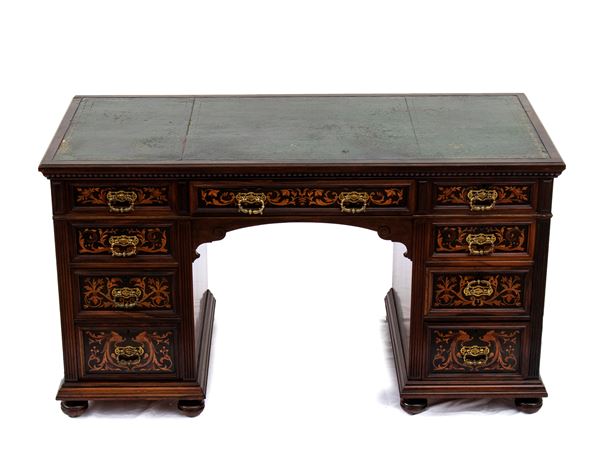75
GILLOWS OF LANCASTER
English Victorian inlaid desk, First half of the 19th century
Height x width x depth 76x137x63 cm
rare double pedestal desk made of mahogany and rosewood and inlaid on the front with fruit woods in floral motifs.
Stamped Gillows Lancaster.
Stamped Gillows Lancaster.
Literature:
Robert Gillow, the founder of Gillows, began his career as a cabinet maker in 1731 after completing his apprenticeship as a joiner and furniture craftsman. He had already become a Freeman of Lancaster in 1728 and soon entered a business partnership with George Haresnape. His two sons, Richard and Robert, later joined him in the enterprise, expanding the business to London, where many affluent clients resided. This strategic move helped establish Gillows as one of the most highly regarded cabinet-making firms of its time.
During the 1740s, Gillows chartered ships to import mahogany from the West Indies and Jamaica, ensuring the use of high-quality, slow-grown solid woods—materials that are rarely found in today's market. In addition to fine mahogany, they incorporated rare veneers and decorative painted finishes such as Japanning. The firm also specialized in upholstered furniture, maintaining a team of skilled upholsterers and cabinetmakers.
Beyond their own exceptional designs, Gillows collaborated with renowned designers such as Chippendale, Sheraton, and Hepplewhite. They were also pioneers in innovative furniture pieces, creating unique designs like the trou-madame, a ladies’ version of a billiard table. Among their many notable inventions were the extending telescopic dining table, the revolving top library table, and the secretaire drawers. One of their most famous creations was the Davenport desk, a compact ladies’ writing desk originally designed for Captain Davenport. Additionally, Gillows produced a wide range of furniture, from linen presses and chests of drawers to occasional tables and even coffins, contributing to their status as one of the wealthiest families in England at the time.
The earliest identifying marks were printed labels reading Gillow and Taylor, though these are extremely rare today as they often tore or detached over time. From the 1780s to around the 1850s-60s, the company used the Gillows Lancaster stamp, which was later shortened to Gillow. In the 1860s, markings evolved to include a capital L along with a serial number, sometimes accompanied by Gillows Lancaster. During the late Victorian era, the stamp changed to Gillow & Co., followed by Waring & Gillow, often accompanied by a small brass plate.
Robert Gillow, the founder of Gillows, began his career as a cabinet maker in 1731 after completing his apprenticeship as a joiner and furniture craftsman. He had already become a Freeman of Lancaster in 1728 and soon entered a business partnership with George Haresnape. His two sons, Richard and Robert, later joined him in the enterprise, expanding the business to London, where many affluent clients resided. This strategic move helped establish Gillows as one of the most highly regarded cabinet-making firms of its time.
During the 1740s, Gillows chartered ships to import mahogany from the West Indies and Jamaica, ensuring the use of high-quality, slow-grown solid woods—materials that are rarely found in today's market. In addition to fine mahogany, they incorporated rare veneers and decorative painted finishes such as Japanning. The firm also specialized in upholstered furniture, maintaining a team of skilled upholsterers and cabinetmakers.
Beyond their own exceptional designs, Gillows collaborated with renowned designers such as Chippendale, Sheraton, and Hepplewhite. They were also pioneers in innovative furniture pieces, creating unique designs like the trou-madame, a ladies’ version of a billiard table. Among their many notable inventions were the extending telescopic dining table, the revolving top library table, and the secretaire drawers. One of their most famous creations was the Davenport desk, a compact ladies’ writing desk originally designed for Captain Davenport. Additionally, Gillows produced a wide range of furniture, from linen presses and chests of drawers to occasional tables and even coffins, contributing to their status as one of the wealthiest families in England at the time.
The earliest identifying marks were printed labels reading Gillow and Taylor, though these are extremely rare today as they often tore or detached over time. From the 1780s to around the 1850s-60s, the company used the Gillows Lancaster stamp, which was later shortened to Gillow. In the 1860s, markings evolved to include a capital L along with a serial number, sometimes accompanied by Gillows Lancaster. During the late Victorian era, the stamp changed to Gillow & Co., followed by Waring & Gillow, often accompanied by a small brass plate.
€ 4.000,00 / 6.000,00
Estimate
€ 1.600,00
Starting price
Unsold
Live auction 328
Antique Furniture, Objects of Art, Curiosities
Antique Furniture, Objects of Art, Curiosities
with a selection of carpets
Palazzo Caetani Lovatelli, tue 4 March 2025
SINGLE SESSION 04/03/2025 Hours 15:30
New lots currently at auction
















